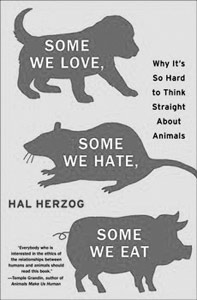Reading Between the Lines: An in-depth, well-packaged look at human-animal relationships
 CREDIT: HARPER COLLINS
CREDIT: HARPER COLLINSSome We Love, Some We Hate, Some We Eat is very upfront about what it contains, with its right-on-the-tin title. Written by snake expert and professor of psychology Hal Herzog, Some We Love is essentially the beginner's handbook to the field of anthrozoology, the study of animal-human relationships, a newly emerging yet incredibly important field.
Some We Love isn't all business, though. While a far cry from being a manual on how to improve your relationship with your Jack Russell terrier, the book nevertheless avoids being overtly technical and flighty in describing the various levels of society's relationships with animals, from sociological to biological, all with a rather nice touch of humour that definitely avoids making this pop-sci book a chore to read. Why do we find otters cute, but salamanders disgusting? How much of our perception of what an animal's role is in our lives is based on socialization versus some sort of biological bond? And, of course, what does the field of anthrozoology really entail? Questions like these only barely scratch the surface of the book's bulk. You'll learn how animals play a larger role in our lives than just begging us for a second Milk-Bone.
Although the book does touch upon animals a lot, Some We Love is really a book about human behaviour, and attempts to analyze the reasons behind our differing attitudes towards animals and the way they affect us. And by differing, I mean Japanese children adopting bugs (used for elaborate bugfights) that would make the average North American child soil themselves differing. The book truly shines in its discussion of an impressively wide range of topics simply related to humananimal behaviours. Between finding out the truth behind the long-existing debate of 'dog people versus cat people,' and whether children who are abusive towards animals are potential serial killers (and the people who propagate this statement), there's just a lot of, well, stuff you'll learn about the placement of animals (which, you will learn, isn't as simple as 'pet' and 'do NOT go near it') in human society. Ever hear of a 'therapy dolphin'? Or perhaps a wolf dog shelter? Regardless of whether you have heard of the above, Some We Love is guaranteed to introduce you to at least one or two things about animals you probably never even thought of. Like how our ability to 'interpret' what we would consider an animal comprises a whole section of our brain's neurological wiring.
While the book doesn't give definite answers to the reasons behind our behaviours (then again, if it could, the field of anthrozoology would cease to exist altogether), it at least goes into the whys of our attitudes towards animals. The important factors behind human behaviour — neurobiology, culture, socialization and more — are all accounted for, addressed through the dissection of various experiments carried out by anthrozoologists over the years. Some We Love is meaty with examples of our wavering sense of morality when it boils down to animals versus humans. My personal favourite example of this is the spin on the rather infamous moral conundrum of the Trolley Problem. Would it be morally acceptable to push a rather hefty innocent bystander into the path of an out of control trolley if it meant saving the lives of five people tied to the tracks? Alright, now replace all the people with several small chimps and one rather sizable chimp. The difference in how people answered both conundrums is rather astounding, and is one of the many ways the book addresses the rather uncomfortable topic of how the way we value animals differs from the way we value humans.
I really am not exaggerating when I say that the stuff I've described above only barely scratches the book's surface. Some We Love charts in at around 250 pages of content (with the rest being a fairly hefty recommended reading list) but covers a truly impressive range of topics on the nature of human-animal relationships. Some We Love, is a great springboard to exploring the world of anthrozoology. I have completed this review without the single use of an animal-related pun, and that's just doggone impressive. Wait, does doggone count?
Reading Between The Lines explores books that you may have missed out on that are worth your while. If you have a book to suggest, email Eshaan at e_gupta@fanshaweonline.ca.













